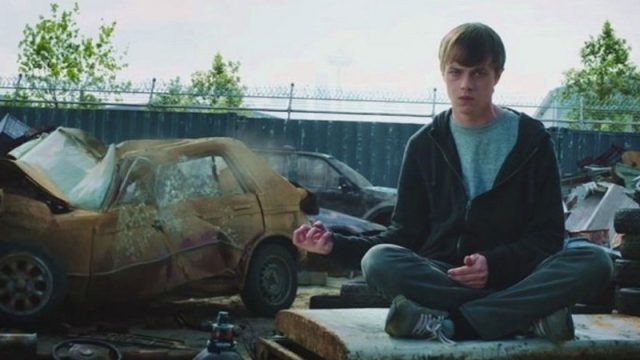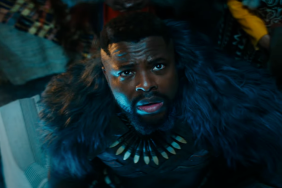Remember about 10 years ago when the “found footage” flick was all the rage in cinemas? The trend kicked off with The Blair Witch Project in 1999 but didn’t really get going until Cloverfield blew the lid off the box office a decade later. And while the format certainly breathed new life to the horror genre, resulting in a series of successful Paranormal Activity movies and the occasional V/H/S success story, Josh Trank’s Chronicle remains the lone entry to really push the possibilities of the found footage movie.
Chronicle released 10 years ago today on February 3, 2012, and grossed $126.6 million against a $12 million budget on the back of stellar reviews (85% on Rotten Tomatoes) and a thrilling marketing campaign that showed off the flick’s superheroic antics.
An argument could be made that Chronicle turned Michael B. Jordan into a star, as the role led to the critically acclaimed one-two punch of Fruitvale Station and Creed over the next few years.* While Jordan’s co-stars, Dane DeHaan and Alex Russell found success in their own respective careers.
Here’s the plot synopsis in case you need a refresher: “Andrew (Dane DeHaan) is a socially awkward, introverted teen whose main form of escape and expression is a video camera. But things begin to change when Andrew, his cousin Matt (Alex Russell) and popular classmate Steve (Michael B. Jordan) discover a mysterious substance that leaves them with incredible powers. As their abilities become more powerful, the teens’ lives spin out of control when their darker sides begin to emerge. Andrew’s camera captures the unfolding events.”
At the time of its release, the superhero genre was still a mixed bag with popular entries such as Sam Raimi’s Spider-Man offset by forgettable fares such as 2003’s Daredevil and 2011’s Green Lantern. The Marvel Cinematic Universe was still in its early stages, having just released Iron Man 2 to middling results — The Avengers would ignite the box office three months later — while Christopher Nolan’s Dark Knight trilogy was about to unveil its anticipated final chapter.
Indeed, the highest-grossing comic book flicks at the time of Chronicle’s release were The Dark Knight ($998 million worldwide) and Spider-Man 3 ($894 million), and even the lucrative box office receipts of those films pale in comparison to the likes of Spider-Man: No Way Home ($1.74 billion worldwide and counting) or the last two Avengers flicks (which cumulatively grossed $4.8 billion).
All that to say, the superhero landscape was decidedly different in February of 2012, which allowed Chronicle to swoop in with its decidedly unique take on the genre, one that cleverly and successfully combined the comic book film with the found footage formula. And while Trank’s pic more or less follows the same documentary structure established in The Blair Witch Project, the director still finds clever ways to exploit the format in ways we hadn’t seen before (and haven’t seen since).
Chronicle spends its early goings exploring the life of our main protagonist (and eventual antagonist), Andrew, who has decided to film things with his home video camera because “it’s important.” We meet his sickly mother (Bo Petersen), his lone friend Matt (who makes the obligatory reference to the camera), witness the difficulties he experiences at school — bullies, angry cheerleaders, violent crackheads, oh my! — and top it all off with a list from dear ole abusive dad (Michael Kelly).
These early moments carry an eerie foreboding because we know what’s about to happen to Andrew; and subsequently, his abusers.
After a sojourn to a rave, where we meet Ashley Hinshaw’s plucky Casey Letter, Andrew is whisked away by the likable Steve Montgomery (who remembers Andrew from freshman homeroom) to check out a hole he and Matt discovered. The trio takes a chance, leaps into the pit, and discovers a mysterious glowing rock.
One of the reasons the found footage format is such an effective tool is the way it allows directors to leap over filler scenes without disrupting the flow of the film. Ordinarily, the meteor discovery would lead to one or two scenes where the characters go their separate ways, discover their powers, and meet up later to discuss. In Chronicle, Trank cuts to black and re-opens days later with the trio messing around with their newfound skills.
Interestingly, we’re only 19-minutes into the film and already Trank has effectively established Andrew’s thankless situation, a superhero origin story, and the budding friendship between the three protagonists. It’s very efficient filmmaking, and it really only works because we’ve seen this tale countless times before, and know exactly where it’s headed. Yet, there’s a certain joy that comes from anticipating the next scene — we’re never sure how far ahead the story will jump. Each cut leads to a new surprise, whilst simultaneously inching us closer to Andrew’s eventual downfall, both of which stir our senses in intriguing ways.
In-between the wacky hijinks, Trank slowly unveils each character’s underlying motivation through quiet conversations. It’s interesting that none of them ever think to use their powers for the good of mankind, and seem to accept them merely as new toys to play with.
Except for Andrew, who goes overboard and knocks an overzealous driver off the road.
I love how the gradual increase in the boys’ power necessitates more discipline and control. Where the ability to lift a fork or pull the occasional prank induced laughs, greater abilities — super strength, flight, invulnerability — causes the young men to shake in their boots. With great power …
Eventually, the boys are able to fly, which results in another well-timed jump cut that induced plenty of gasps from my opening night audience:
Now, to be fair, the special effects aren’t quite up to snuff with, say, Man of Steel, but the flying sequences are still exhilarating; I love how the group uses their superpowers to play football in the clouds. Little details like that are what make Chronicle stand out from the rest of the pack because they help sell the concept. Here we have three young men who can fly and they act like they’re windsurfing at the beach, and we completely buy how the experience would make them act the way they do — because we would all behave the same way!
Another interesting note is the way Trank employs the various filming devices to document the experience. Andrew uses his powers on his cellphone, which revolves around his person, and slowly becomes more and more obsessed with filming his achievements. It works as a story device that fits comfortably into the found footage style, but also allows Trank to capture the action from a number of different angles. Cool stuff.
Also, I appreciate how flying quickly becomes commonplace among the guys. At one point, Matt heads off to his grandmother’s house by nonchalantly taking off into the sky. Andrew and Steve decide to head to the city. “Nah, it’s rush hour,” Steve says. “So?” replies Andrew. “Oh, yeah!”
Kids.
After a high school magic show designed to increase Andrew’s popularity, a sexual experience gone awry sends the young man, and by design, the rest of the film down an extremely dark course. There’s a cool scene that demonstrates just how powerful — and angry — Andrew has become:
This bit is followed by a violent encounter between Andrew and his dad that doesn’t end well. And while the acting is certainly a little spotty, Trank hammers the point home quite adeptly.
The next sees Andrew “accidentally” kill Steve. Some criticisms of the film felt Andrew’s downward spiral was far too quick, but I see it as the proverbial straw that broke the camel’s back. Andrew’s issues run deep and to think a few ounces of popularity would somehow negate the pains he experienced in life is foolhardy. The moment where his first sexual encounter goes awry, and Steve reacts by laughing at him, Andrew quite literally snaps. He doesn’t seek to hurt anyone, but discovers he’s quite adept at inflicting pain upon others, leading to this disturbing bit:
Andrew sees himself as an apex predator and eventually decides to use his powers to attain money. One of my favorite scenes of the film is the bit where he takes down a group of drug pushers. The staging of the sequence is terrific, if not outright terrifying:
Of course, this scene only works if you fully buy into Andrew’s plight. The young man needs medication for his sick mother, his loser dad has no money. To his credit, Andrew starts at the bottom and works his way up — he’s not a bad kid, just a broken soul in desperate need of guidance … and a hug.
His first actual murder comes by accident and more out of desperation than cruelty. Naturally, now scarred and in the hospital, Andrew’s father arrives to further complicate matters.
This bit naturally leads to the big finale, which is just … really cool, if not a little brief.
There are a number of amazing moments during the grand finale and Trank captures it all through cell phones, security footage, and news cameras, but still manages to make the action flow at a quick pace. Keep in mind, this is all before The Avengers and Man of Steel, and likely the first to truly convey massive amounts of superhero carnage.
Still, Chronicle’s spectacular finale only works because the first two acts take the time to develop a powerful (and extremely dark) human story that resonates even today.
I honestly had no intention of diving this deep into the movie but found myself absorbed by its drama and wowed by its action. It’s too bad Trank hasn’t done anything on this scale since, because he demonstrates total control over his craft. And while Chronicle is a little rough around the edges, it remains a damned fine superhero film, and a grossly overlooked found-footage gem.
*There was also a little movie called Fantastic Four that reteamed Jordan with his Chronicle director, but we should talk about that as often as we talk about Bruno-no-no.










